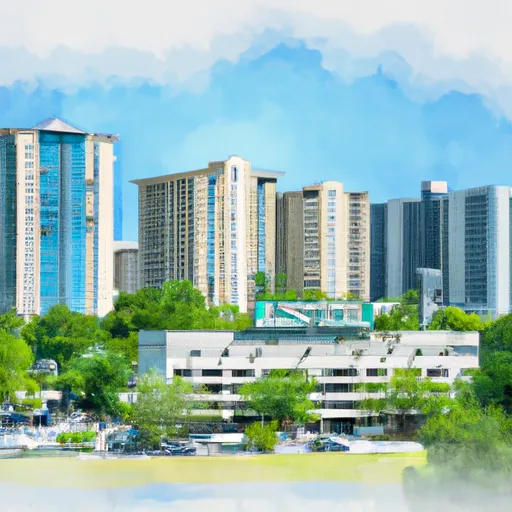-
 Snoflo Premium
Snoflo Premium
Get unlimited access to all our content
With no Ad interruptions! - Start Your Free Trial Login with existing account
Silver-Springs
Eden Index
Climate
7.3
•
Recreation
6.5
•
Community
0.8
•
Safeguard
5.4/10

Silver Springs, Florida is a charming town located in Marion County, known for its natural beauty and outdoor recreation opportunities. The climate in Silver Springs is typically warm and humid, with hot summers and mild winters. The region experiences abundant rainfall throughout the year, contributing to the area's lush vegetation and diverse hydrology constituents.
One of the main attractions in Silver Springs is the Silver Springs State Park, which offers a variety of outdoor activities. Visitors can explore the crystal-clear springs by kayaking, canoeing, or taking a glass-bottom boat tour, where they can marvel at the stunning underwater scenery and observe various aquatic life forms. The park also features hiking and biking trails, picnic spots, and a campground, providing ample opportunities to immerse oneself in nature.
In addition to the state park, the Ocala National Forest is nearby, offering further outdoor pursuits such as hiking, fishing, and wildlife viewing. The forest is home to numerous rivers, springs, and lakes, making it a haven for water-based activities.
Overall, Silver Springs, Florida provides a wonderful environment for those seeking to enjoy the outdoors, with its pleasant climate, diverse hydrology constituents, and numerous recreational opportunities.
What is the Eden Index?
The Snoflo Eden Index serves as a comprehensive rating system for regions, evaluating their desirability through a holistic assessment of climate health, outdoor recreation opportunities, and natural disaster risk, acknowledging the profound impact of these factors on livability and well-being.
Climate Health Indicator (CHI): 7.3
Silver-Springs receives approximately
1284mm of rain per year,
with humidity levels near 88%
and air temperatures averaging around
21°C.
Silver-Springs has a plant hardyness factor of
9, meaning
plants and agriculture in this region tend to thrive here all year round.
By considering the ideal temperature range, reliable water supplies, clean air, and stable seasonal rain or snowpacks, the Climate Health Indicator (CHI) underscores the significance of a healthy climate as the foundation for quality living.
A healthy climate is paramount for ensuring a high quality of life and livability in a region, fostering both physical well-being and environmental harmony. This can be characterized by ideal temperatures, reliable access to water supplies, clean air, and consistent seasonal rain or snowpacks.
Weather Forecast
Streamflow Conditions
St. Johns
Area Rivers
St. Johns
Snowpack Depths
St. Johns
Reservoir Storage Capacity
St. Johns
Groundwater Levels
Recreational Opportunity Index (ROI): 6.5
The Recreational Opportunity Index (ROI) recognizes the value of outdoor recreational options, such as parks, hiking trails, camping sites, and fishing spots, while acknowledging that climate plays a pivotal role in ensuring the comfort and consistency of these experiences.
Access to outdoor recreational opportunities, encompassing activities such as parks, hiking, camping, and fishing, is crucial for overall well-being, and the climate plays a pivotal role in enabling and enhancing these experiences, ensuring that individuals can engage in nature-based activities comfortably and consistently.
Camping Areas
| Campground | Campsites | Reservations | Toilets | Showers | Elevation |
|---|---|---|---|---|---|
| Big Bass | 34 | 69 ft | |||
| Big Scrub | 50 | 145 ft | |||
| Lake Louisa State Park | None | 154 ft | |||
| Lake Griffin State Rec Area | None | 85 ft | |||
| Fore Lake | 100 | 82 ft | |||
| Salt Springs | 267 | 26 ft | |||
| Gores Landing County Park | None | 31 ft | |||
| Saddle Creek County Park | None | 111 ft | |||
| Santos Rec Area State Park | 24 | 74 ft | |||
| Withlacoochee River Park | 10 | 94 ft |
Catastrophe Safeguard Index (CSI):
The Catastrophe Safeguard Index (CSI) recognizes that natural disaster risk, encompassing floods, fires, hurricanes, and tornadoes, can drastically affect safety and the overall appeal of an area.
The level of natural disaster risk in a region significantly affects safety and the overall livability, with climate change amplifying these risks by potentially increasing the frequency and intensity of events like floods, fires, hurricanes, and tornadoes, thereby posing substantial challenges to community resilience and well-being.
Community Resilience Indicator (CRI): 0.8
The Community Resilience Indicator (CRI) recognizes that education, healthcare, and socioeconomics are crucial to the well-being of a region. The CRI acknowledges the profound impact of these elements on residents' overall quality of life. By evaluating educational resources, healthcare accessibility, and economic inclusivity, the index captures the essential aspects that contribute to a thriving community, fostering resident satisfaction, equity, and social cohesion.

